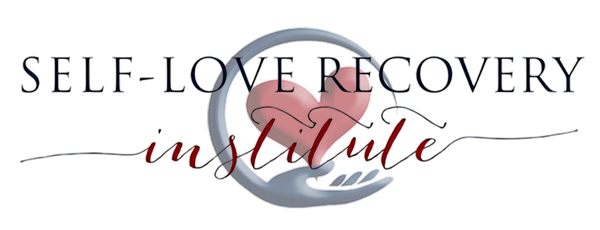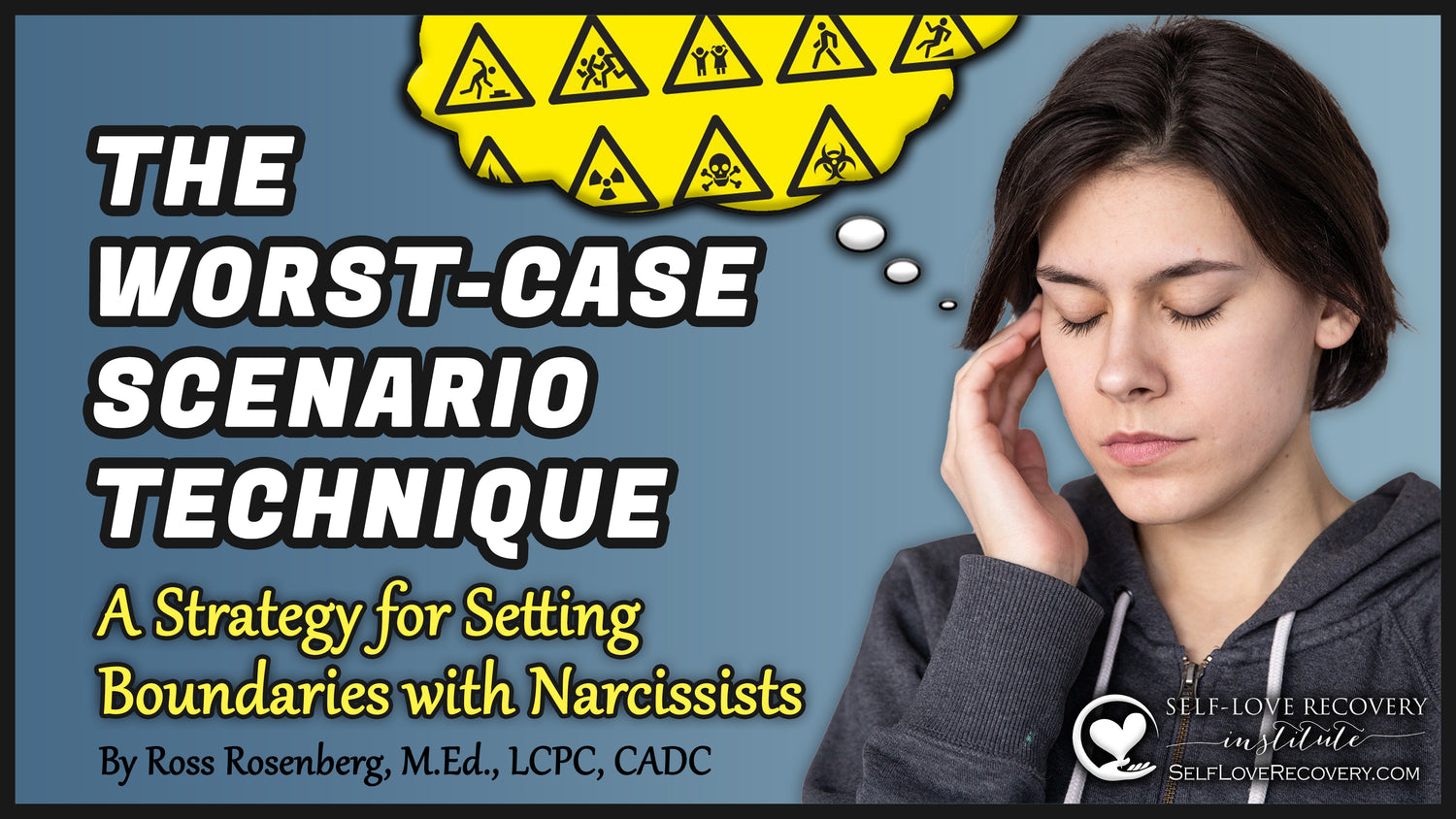
Written by Ross Rosenberg, M.Ed., LCPC, CADC
Self-Love Recovery Institute — President/CEO
Psychotherapist, Educator, Author, Expert Witness
The worst-case scenario technique (TWS) is a defensive strategy developed to aid people with self-love deficit disorder or SLDD (codependency) to be confident with the boundaries they set with severely narcissistic loved ones. It is one of many techniques developed for my Self-Love Recovery Treatment Program. The predominant theme in its fifth stage, “Preparing for the Narcissistic Storm,” is represented by a term I coined - predictive awareness. Success in this stage gives the codependent, which I now refer to as self-love deficient or SLD, all the abilities and tools to succeed in the next stage, “Setting Boundaries in a Hostile Environment.”
Predictive awareness is the proactive accumulation of knowledge and insight into one’s vulnerabilities to narcissistic abuse, especially the tactics that render them powerless to protect themselves. By openly and courageously studying this critically important information, recovering SLDs get a rare glimpse of the narcissist’s dark, despicable, and often hidden controlling and dominating agenda. Learning about how SLDs are rendered powerless, especially their role in losing or giving it up, becomes a crucial recovery benchmark.
Perhaps the most crucial insight resulting from the consistent use of predictive awareness is an optimistic belief that survival, freedom, and the development of self-love abundance are possible. To achieve freedom from narcissistic abuse, the victim wanting to turn survivor must proactively study their adversary so that they master crucial information such as why their partner hurts them, how they do execute their plans, understand their strategies and methods, and why they consistently fall prey to them. In other words, to escape or “win the war,” they must understand what happened in each battle, why they could never win, how they were turned against themselves, and how it all led to constant losses and continued surrender.
I believe Sun Tzu, the Chinese military general, strategist, philosopher, and author of the classic book The Art of War, was an expert on these questions. For example, consider this quote of his:
“If you know yourself but not the enemy, for every victory gained, you will also suffer a defeat. If you know neither the enemy nor yourself, you will succumb in every battle.”
Like mastering chess, skill mastery is never enough to become a champion-level player. Combining knowledge of the game’s mechanics, astute observation skills, deliberate moves, and, perhaps most importantly, an intuitive ability to predict their opponent’s next moves will almost guarantee a series of wins. Hence, using predictive awareness and its subset of the below techniques I created will not only pave the road to freedom but, through the journey, lead to the neutralization of SLDD and the natural transition to its cure: self-love abundance.
While predictive awareness is the overarching strategy that enables the worst-case scenario, Observe Don’t Absorb, three-strike boundary, and neutralizing induced conversation techniques and strategies to be effective, none are more important than completing my 11-Stage Self-Love Recovery Treatment Program. The strategy, and many others, account for the program’s fifth stage, “Preparing for the Narcissistic Storm.”
Although each strategy has a singular purpose, all will neutralize what once seemed like immovable obstacles while opening up further safe pathways that all lead to the relationship’s “exit sign.” In other words, mastery of these techniques and progress in the Self-Love Recovery Treatment Program (SLRP) will help a person escape the relationship with their pathologically narcissistic partner while not getting caught or hooked into their partner’s web of power, control, manipulation, and abuse. In addition, pursuing the “cure” for SLDD – Self-Love Abundance – will finally be within reach! To learn more about the SLRP Program and these techniques, consider my six-hour educational seminar entitled “Tips, Tools, & Strategies to Overcome Narcissistic Abuse.”
Ideally, the use of WCS should be facilitated by a trustworthy and competent psychotherapist. However, when such a resource is unavailable, choose a professional with narcissistic abuse and SLDD (codependency) experience or a trusted and, if possible, experienced friend or loved one.
The overarching goal of WCS is to accurately predict the absolute worst consequence of any course of action so that an objective and accurate cost-benefit analysis can be performed. In other words, WCS safely facilitates an objective decision-making process that when made, is predicted to cause a cascade of potential consequences. Because SLDs are typically insecure, pessimistic, and gaslit to expect the very worst reaction to an impending plan to terminate (escape) their relationship, their reliance on WCS will help manage their anxiety, fear, and negative thinking so that various strategies can be evaluated.
By accurately analyzing and contemplating realistically expected consequences, without the interference of the above, SLDs can decide if they can survive the worst-case scenario enough so that their exit plans were worth the suffering. This process will require them to accurately determine if they have access to an appropriate level of internal (emotional) and external resources to survival is confidently predicted. Because of indoctrinated fear, pessimism, weaknesses, and a lack of support infect any SLD’s escape plans, knowing exactly what will happen and if it is survivable will make all of the difference. Hence, with such assurances and confidence over their realistic expectations, and hopes the “worst case” won’t happen, then they can move forward “full steam ahead” toward their upcoming victorious escape.
Accurately predicting the absolute worst-case scenario may seem pessimistic, but it is not. Setting boundaries on someone with a history of quickly crushing rebellion or attempts at escaping requires an ability to mirror the thought and decision-making processes of the enemy. By getting into their head, it will be possible to understand the why, how, and when they will execute their well-honed and often practiced power, control, and protective strategies.
In addition, WCS requires the development of a top-ten list of the worst possible consequences of the escape plan. Because of the impact of chronic trauma, the assistance of an objective party who both knows the SLD and the narcissist will be helpful with this task. With a completed list, the discussions and analysis should then whittle down the list to the absolute worst possible consequence. With the identification of the most severe consequence(s), an objective analysis of survivability should follow and a decision-making process can occur. If it is determined that the SLD can not only survive but be able to execute the rest of their plan, then the execution plans should provoke or trigger manageable anxiety and fear.
To understand the potential intensity of the narcissist’s reaction to the escape plan, consider the analogy of choking a person or depriving them of oxygen. In response to this aggravated threat to their life, this becomes a do-or-die situation. Hence, like any person faced with imminent death, they will muster unimaginable levels of overt, covert, and passive forms of aggression and any other lifesaving countermeasures.
The above analogy is justified when considering the narcissist’s characteristic core shame, fear of loneliness, and intense abandonment reactions. Although such awareness is dissociated from their awareness, any threat to what the narcissist most values and fears will elicit the full brunt of their protective capabilities.
Although the identification of the worst-case scenario is the foremost goal, the discovery and analysis of the emotional impediments must occur. If, for example, the SLD determines chronic depression, anxiety, and debilitating fear are likely to be activated, then an analysis, discussion, and planning of the best strategy to control or neutralize them should occur. This process is especially vital considering most SLDs are chronic victims of punishing abuse, neglect, deprivation, and various forms of mind control and gaslighting. This process should not be rushed and preferably be facilitated by a trauma-informed psychotherapist.
As important to the above analyses and planning processes is the importance to isolate and neutralize chronic pessimistic thought and decision-making patterns. If such “stinking thinking” patterns do not derail this process, the self-fulfilling prophecy surely will. Such a prophecy occurs when a rigid belief of an outcome unconsciously sabotages any other potential outcome. For example, if the SLD believes they will never find a lover who is not a narcissist, this belief sets in motion a self-sabotaging process that dashes their hopes while confirming their fears and predictions.
With an accurate WCS conclusion, the next step is to analyze if all readily available resources will be sufficient for the predicted worst-case scenario outcome. Such include but are not limited to emotional, personal, financial, physical, legal, and relational resources. If the analysis uncovers an absence of necessary resources, then the task at hand is to seek alternatives. Once the availability and immediate access to the resources have been determined, practicing the boundary event and their potential use should occur.
Although the primary goal is to escape, staying safe will always take precedence. Hence, an important but not preferred outcome of WCS is the realization that the expected worst consequence will be too severe to manage or proactively mitigated. The prediction might seem disheartening, but it is valuable information from which the next best plan can be developed.
Since WCS is a learning, practicing, evaluating, and planning-again process, a wargames analogy may be helpful. For a military force, wargames elicit crucial analytical and predictive information about what is likely to succeed, fail, and everything in between. Hence, deciding that any given plan cannot succeed is not necessarily a negative outcome. On the contrary, it can be extremely valuable to the development of the next set of potentially viable plans.
In conclusion, the mastery of predictive awareness and the worst-case scenario techniques can be lifesaving, especially to an embattled, beaten down, but miraculously courageous and heroic SLD.


0 comments